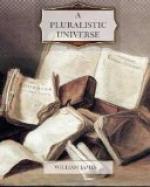in the isolation in which our verbalized logic keeps
it? They exist only
durcheinander.
Reality always is, in M. Bergson’s phrase, an
endosmosis or conflux of the same with the different:
they compenetrate and telescope. For conceptual
logic, the same is nothing but the same, and all sames
with a third thing are the same with each other.
Not so in concrete experience. Two spots on our
skin, each of which feels the same as a third spot
when touched along with it, are felt as different
from each other. Two tones, neither distinguishable
from a third tone, are perfectly distinct from each
other. The whole process of life is due to life’s
violation of our logical axioms. Take its continuity
as an example. Terms like A and C appear to be
connected by intermediaries, by B for example.
Intellectualism calls this absurd, for ‘B-connected-with-A’
is, ‘as such,’ a different term from ‘B-connected-with-C.’
But real life laughs at logic’s veto. Imagine
a heavy log which takes two men to carry it. First
A and B take it. Then C takes hold and A drops
off; then D takes hold and B drops off, so that C
and D now bear it; and so on. The log meanwhile
never drops, and keeps its sameness throughout the
journey. Even so it is with all our experiences.
Their changes are not complete annihilations followed
by complete creations of something absolutely novel.
There is partial decay and partial growth, and all
the while a nucleus of relative constancy from which
what decays drops off, and which takes into itself
whatever is grafted on, until at length something
wholly different has taken its place. In such
a process we are as sure, in spite of intellectualist
logic with its ‘as suches,’ that it
is
the same nucleus which is able now to make connexion
with what goes and again with what comes, as we are
sure that the same point can lie on diverse lines
that intersect there. Without being one throughout,
such a universe is continuous. Its members interdigitate
with their next neighbors in manifold directions, and
there are no clean cuts between them anywhere.
The great clash of intellectualist logic with sensible
experience is where the experience is that of influence
exerted. Intellectualism denies (as we saw in
lecture ii) that finite things can act on one another,
for all things, once translated into concepts, remain
shut up to themselves. To act on anything means
to get into it somehow; but that would mean to get
out of one’s self and be one’s other, which
is self-contradictory, etc. Meanwhile each
of us actually is his own other to that extent,
livingly knowing how to perform the trick which logic
tells us can’t be done. My thoughts animate
and actuate this very body which you see and hear,
and thereby influence your thoughts. The dynamic
current somehow does get from me to you, however numerous
the intermediary conductors may have to be. Distinctions
may be insulators in logic as much as they like, but
in life distinct things can and do commune together
every moment.




